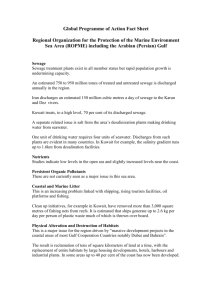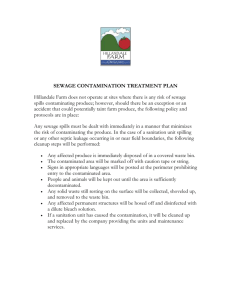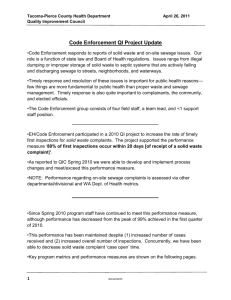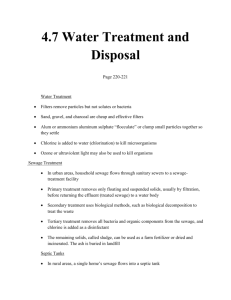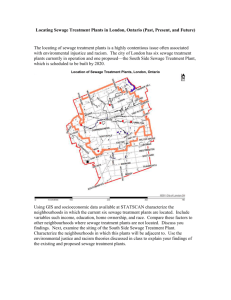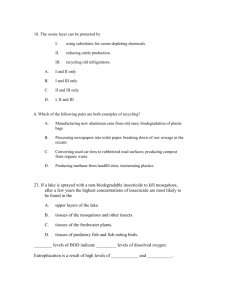ON-SITE SEWAGE MANAGEMENT STRATEGY
advertisement
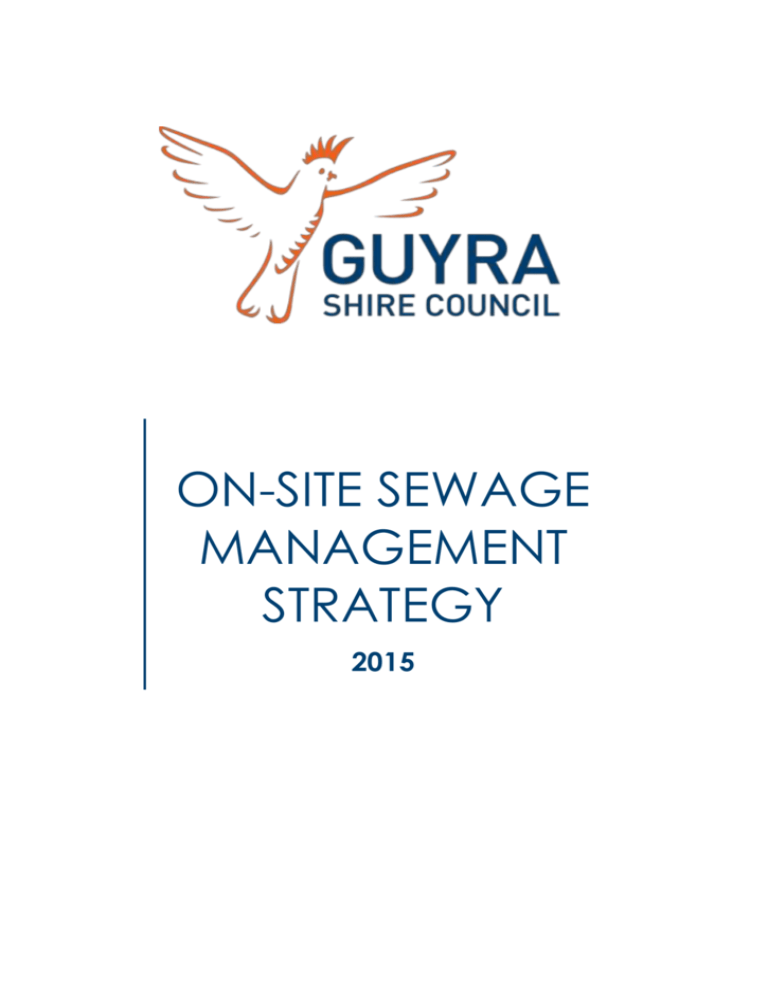
ON-SITE SEWAGE MANAGEMENT STRATEGY 2015 GUYRA SHIRE COUNCIL On-Site Sewerage Management Strategy EXECUTIVE SUMMARY ............................................................................................................................................ 4 1.0 INTRODUCTION ................................................................................................................................................. 6 1.1 Legislative Changes ....................................................................................................................................... 6 1.2 Commencement ........................................................................................................................................... 6 1.3 Change of Ownership ................................................................................................................................... 6 1.4 Exemptions ................................................................................................................................................... 6 2.0 OBJECTIVES ....................................................................................................................................................... 7 3.0 GOALS ............................................................................................................................................................... 7 4.0 BACKGROUND ................................................................................................................................................... 8 4.1 Legislation and Guidelines ............................................................................................................................ 8 4.2 Reasons for Legislation ................................................................................................................................. 8 5.0 LOCATION AND CIRCUMSTANCES ..................................................................................................................... 9 5.1 Location ........................................................................................................................................................ 9 5.2 Climate .......................................................................................................................................................... 9 5.3 Population and System Estimates ................................................................................................................ 9 5.4 Potential Problem Areas ............................................................................................................................. 10 5.5 Linkages Between this Strategy and Council’s Strategic Planning Process ................................................. 10 6.0 PROGRAMS AND RESOURCES ......................................................................................................................... 11 6.1 Requirements ............................................................................................................................................. 11 6.2 Staff and Financial Resources ..................................................................................................................... 11 7.0 APPLICATIONS AND APPROVALS ..................................................................................................................... 11 7.1 Applications ................................................................................................................................................ 11 7.2 Fees ............................................................................................................................................................. 12 7.3 Performance Standards .............................................................................................................................. 12 7.4 Failure to Meet Performance Standards etc .............................................................................................. 13 8.0 INSPECTIONS ................................................................................................................................................... 13 8.1 General ....................................................................................................................................................... 13 8.2 Initial Risk Assessment ................................................................................................................................ 13 Page | 2 GUYRA SHIRE COUNCIL On-Site Sewerage Management Strategy 8.3 Renewal Inspections ................................................................................................................................... 14 8.4 Inspection Reporting................................................................................................................................... 14 9.0 CATEGORIES OF RISK OF INSTALLATIONS ........................................................................................................ 14 9.1 Categories of Risk ....................................................................................................................................... 14 9.2 Indicative Risk Criteria ................................................................................................................................ 14 9.3 Low Risk Indicative Criteria ......................................................................................................................... 15 9.4 Medium Risk Indicative Criteria .................................................................................................................. 15 9.5 High Risk Indicative Criteria ........................................................................................................................ 16 10.0 REVIEW OF AND CHANGES TO CATEGORIES OF RISK .................................................................................... 17 10.1 Review of Categorisation .......................................................................................................................... 17 10.2 Re-Categorisation of Systems ................................................................................................................... 17 10.3 Limitation on Re-Categorisation ............................................................................................................... 18 11.0 RECORDS AND APPLICATIONS FOR RENEWAL ............................................................................................... 19 11.1 Records ..................................................................................................................................................... 19 11.2 Notice of Renewal ..................................................................................................................................... 19 12.0 EVALUATION OF IMPLEMENTATION OF THIS STRATEGY............................................................................... 19 12.1 Monitoring ................................................................................................................................................ 19 12.2 Reporting .................................................................................................................................................. 20 13.0 REVIEW OF THIS STRATEGY ........................................................................................................................... 20 REFERENCE DOCUMENTS ..................................................................................................................................... 20 DEFINITIONS ......................................................................................................................................................... 21 Page | 3 GUYRA SHIRE COUNCIL On-Site Sewerage Management Strategy EXECUTIVE SUMMARY The Local Government (General) Regulation 2005, requires owners of land to obtain the approval of Council to operate on-site systems of sewage management. This requirement applies to all new and existing systems. Approvals are personal and do not run with the land, therefore purchasers of land must apply for such approvals within two months of acquisition of land. This strategy sets out council’s response to the legislation and the objectives of the strategy. The broad objective is to ensure there is a system in place to control of on-site sewage management systems within the Shire area. The goals of the strategy are to: • minimise the impact of systems on the environment, • identify the location of all systems in the Shire area, • to establish a partnership between stakeholders to support continuing improvement of on-site sewage management; • educate owners about their systems; • ensure owners are aware of the need to maintain systems; • ensure owners of high, medium and low risk installations are aware of the need to hold current approvals; • provide for the exemption of some low risk systems from the need to obtain approval; • implement a least cost method of supervision of on-site sewage management systems; • provide for charging of fees for approvals; and The legislative reforms were implemented in response to surveys which indicated on-site sewage management systems were failing to meet environmental and health protection standards. The hepatitis A outbreak linked to the consumption of oysters from the Wallis Lakes and the risks in settlement areas of the Murray Darling Basin from septic tank effluent. Guyra is a small to medium rural shire in the New England area of northern NSW. Its population is about 4,397. The six main towns and villages in the Guyra Shire are Guyra, Tingha, Ben Lomond, Ebor, Llangothlin and Black Mountain. Guyra & Tingha townships are sewered but the remaining areas of the Shire including all villages rely on on-site sewage management systems. The implementation of the strategy will involved: • • • • requesting owners to lodge applications for approval to operate; recording such applications; completing an audit of such applications; identifying installations by category of risk; Page | 4 GUYRA SHIRE COUNCIL On-Site Sewerage Management Strategy • only requiring upgrading of systems where they cannot meet the performance standards; • levying of fees determined by Council. Approvals in respect of high and medium risk installations will be issued for two years and five years respectively. Council will determine on an annual basis what fees are to be imposed on the lodgment of applications. All installations will be required to comply with the performance standards set out in the Regulation. Where medium or low risk installations fail to meet those performance standards then the system will automatically change to a high risk classification unless repairs are carried out within 21 days. Council will implement an inspection regime to ensure that the objectives of this strategy are achieved. Initial risk assessments were completed by desktop assessment. A 5% random target group of installations were be inspected to verify the accuracy of those assessments. Council proposes to establish three categories of risk which will be applied to installations, high, medium and low. Installations will be assessed against indicative criteria for each category. Provision is made for reviews of risk assessments. Provision is made for re-categorisation of systems to a lower category over a period of time, although that re-categorisation can only occur once. Council will maintain records of all applications, approvals and exemptions. As required notices of renewal will be sent to owners of systems required to hold current approvals. The strategy is to be the subject of ongoing review, at least in the early stages, and subsequently on a quadrennial basis in the first year after each general Council election. Page | 5 GUYRA SHIRE COUNCIL On-Site Sewerage Management Strategy 1.0 INTRODUCTION 1.1 LEGISLATIVE CHANGES The requirement to obtain approvals to operate sewage management systems is a relatively new concept. Previously Council had the power under the orders provisions of the Local Government Act 1993, to require remedial work to be carried out on faulty sewage management facilities. This power was however reactive to problems and did not seek to ensure problems did not occur as a result of operation of such systems. Clause 45 of the Local Government (General) Regulation 1998, outlines the matters to be taken into consideration in determining applications for approval to install, construct or alter sewage management facilities. This has in effect prescribed the operation of a system of sewage management as an activity for the purpose of Council approval under section 68 of the Local Government Act 1993. This means the owner of any land must obtain the approval of Council to operate any on-site sewage management systems on their land. 1.2 COMMENCEMENT Systems, which were installed after 6 April 1998, cannot be operated unless approval has been obtained. If an application for approval to operate has been lodged with the Council then the system can continue to be used until such time as the application is finally determined by Council. 1.3 CHANGE OF OWNERSHIP An approval to operate on-site sewage system is personal (ie it does not run with the land) and responsibility for performance rests with the owner not the Council. This means that if a property is sold the new owner must in turn apply for an approval to operate. A person, who purchases land on which any sewage management facilities are installed, may continue to operate such system, without the approval so required, for a period of three months from the date on which the property is transferred. It is further provided that, if the new owner applies for such approval within two months of the date of transfer, they may continue to operate the system until such time as the application is finally determined by Council. 1.4 EXEMPTIONS This Strategy provides no local exemptions to the need for approval to install, construct or alter a human waste storage facility or to operate a system of sewage management. Page | 6 GUYRA SHIRE COUNCIL On-Site Sewerage Management Strategy However, Clause. 48 and 75A of the Regulation provide various relevant exemptions from the need for approval throughout NSW, including: • Discharge of domestic sewage into a sewer of Council where in accordance with arrangements made with Council; and • Domestic Greywater diversion in a sewered area where the requirements of cl.75A of the Regulation are met (refer to Part 2.7 of this LAP). Readers should consult the Regulation for further information. Routine maintenance of a septic tank does not require approval. 2.0 OBJECTIVES The objective of this strategy is to ensure that there is a system in place to provide oversight and control of on-site sewage management systems within the Shire. To achieve that objective this strategy intends to ensure: • • • • • • • the protection of groundwater; the protection of surface water; the protection of land and vegetation; the protection of public health and the prevention of public health risk; the maintenance and improvement of community amenity; the maximum re-use of resources consistent with other objectives; the principles of ecologically sustainable development, water cycle management and total catchment management are considered; • the implementation of a least cost system of oversight of sewage management facilities in the Council area. 3.0 GOALS The goals of this strategy are to ensure that, by its implementation: • the impacts of on-site sewage management facilities on the environment will be minimised; • the location of all on-site sewage management facilities will be identified; • a partnership will be developed between Council, householders and service agents to support continuing improvement of on-site sewage management; • the owners of on-site sewage management facilities will be made aware of the type of system/s installed on their premises and of the limitations which may be placed on the operation of that system/s; Page | 7 GUYRA SHIRE COUNCIL On-Site Sewerage Management Strategy • the owners of on-site sewage management facilities will be made aware of the need for ongoing maintenance and that they can be provided with the necessary information and support to ensure that their systems are maintained so that they meet the performance standards set out in the Regulation; • the owners of on-site sewage management facilities identified within this strategy as high, medium and low risk will understand the need to obtain approvals to operate in accordance with the requirements of the Local Government (General) Regulation; • a least cost system of general performance assurance and supervision of on-site sewage management facilities is implemented; • Council can recover some of the costs of implementation of this strategy by charging fees for the issuing of approvals in respect of facilities installed in high, medium and low risk locations; 4.0 BACKGROUND 4.1 LEGISLATION AND GUIDELINES On 9 March 1998 the Minister for Local Government announced new regulatory reforms and guidelines to enable more effective Council regulation and performance supervision of household septic tanks and other small on-site sewage management facilities. The NSW Local Government (General) Regulation 2005, provides both a regulatory framework and performance criteria for the installation, operation and maintenance of all on-site wastewater systems. Where a system services up to 10 persons and flows of less than 2000 litres per day, special certification rules apply to components that may be installed. Systems larger than 2000 litres/day may not require component certification but must meet the same performance outcomes. The guidelines are titled “Environment and Health Protection Guidelines: On-site Sewage Management for Single Households”. 4.2 REASONS FOR LEGISLATION The implementation of the reforms and the release of the guidelines were a response to a range of issues including: • Surveys in many areas had indicated that septic tanks and other on-site sewage management facilities were failing to meet environment and health protection standards in all parts of NSW; • The recent outbreak of hepatitis A linked to the consumption of oysters from the Wallis Lakes was an indicator of the serious health risks involved; • Effluent from septic tanks pose risks in the Murray Darling Basin especially in settlement areas, areas discharging to slow flowing or discontinuous waterways and in areas which rely on groundwater sources for water supply. Page | 8 GUYRA SHIRE COUNCIL On-Site Sewerage Management Strategy 5.0 LOCATION AND CIRCUMSTANCES 5.1 LOCATION The Guyra Shire forms a part of the New England Region of NSW and occupies generally elevated areas falling midway between the ranges and the plains. The Shire covers an area of 4,395 square kilometers and has a population of 4397, (2011 Census). Council’s water monitoring program has found that the quality of ground and surface water is of a high standard. Guyra does have the potential to impact on the Macleay, Clarence and Gwydir catchments. 5.2 CLIMATE Summer temperatures are mild to warm during the period November to March with mean monthly maximum temperatures of 22.5 degrees. Summer nights tend to be mild. Winter days tend to be cool with cold nights having a mean monthly daytime maximum temperature of 10.8 degrees. Guyra has an average rainfall of 881mm. Rainfall is highest during the period from December to February. The climate then is relatively dry with high temperatures. Evapo-transpiration rates are approximately 1200mm per annum and generally exceed rainfall in all months. 5.3 POPULATION AND SYSTEM ESTIMATES The estimated population as indicated by the 2011, census was 4397. The Shire contains one major town Guyra and the village of Tingha both of which are sewered. The four smaller villages including Ebor, Ben Lomond, Llangothlin and Black Mountain all of which rely on on-site sewage management systems for the disposal of their waste. Tingha has had reticulated sewer since 2002, with most premises being connected by the end of 2004. This means that approximately 70% of the Shire’s population live in premises that are serviced by reticulated sewerage. Of the remaining population some 150 live in the other four villages within the Shire, whilst the balance live in rural areas. It is assumed as indicated in the 2011 census approximately 2,700 people live in premises that are served by sewage management systems. It is also estimated that there are approximately 1300 on-site sewage management facilities handling wastes from dwellings and other buildings throughout the shire. Of those systems around 75 would be located in village situations and 1,225 would be located in rural areas. There are, no doubt, a substantial additional number of on-site sewage management facilities associated with non- Page | 9 GUYRA SHIRE COUNCIL On-Site Sewerage Management Strategy residential buildings such as shearing sheds, commercial and industrial premises and the like. There are currently nine septic systems pumping effluent to the sewerage reticulation system in the Guyra town area. 5.4 POTENTIAL PROBLEM AREAS The largest village within the Shire area, is Tingha (population 1174), which, for the most part, now has reticulated sewerage service. Tingha is located approximately 65 km west of Guyra and has developed along Copes Creek. The village is provided with a reticulated water supply, which is drawn from the Inverell water supply. 5.4.1 Council has identified problems on the outskirts of Tingha and has also found individual problem sites on the outskirts of Guyra and in each of the other villages. The main areas of concern are those premises in Tingha and rural areas close to Guyra, which have a reticulated water supply. 5.4.2 5.5 LINKAGES BETWEEN THIS STRATEGY AND COUNCIL’S STRATEGIC PLANNING PROCESS The evaluation and reporting processes, is to be used to ensure that this strategy is both, linked with Council’s strategic planning and reporting processes, and updated on a regular basis. 5.5.1 Council’s current land use and development controls are set out in the Guyra Local Environmental Plan 2012, (and subsequent amendments) and the Guyra Development Control Plan 2015, which relates to development in all areas. These controls can also be overridden or modified by any relevant State Environmental Planning Policies. 5.5.2 Page | 10 GUYRA SHIRE COUNCIL On-Site Sewerage Management Strategy 6.0 PROGRAMS AND RESOURCES 6.1 REQUIREMENTS The legislation requires Council undertakes an initial assessment of all on-site sewage management activities in its area and determine depending on the perceived level of risk on the site. Council must demonstrate that the operators are aware of the performance standards and that systems in use present minimal risk to public health, the environment or community amenity. 6.2 STAFF AND FINANCIAL RESOURCES Staff resources to implement this strategy will be provided from within the staff of Council’s Planning, Regulatory and Community Services Department. Council, in preparing its annual budget, will determine any fees which may be charged for lodgment of applications for approval to operate systems which are still required to obtain approval. 7.0 APPLICATIONS AND APPROVALS 7.1 APPLICATIONS All installations categories will continue to require regular inspections to operate. This means that owners will need to submit applications for approvals prior to the expiry of current approvals. For the purposes of this Policy, an on-site wastewater system is one that collects and treats premises’ wastewater, or separates the black water and the greywater for separate treatment. The system includes the drains and the land application area. The Act requires persons to gain approval from Council to install, modify or remove an onsite wastewater system or any part of such a system. This applies to homeowners, landholders or anyone wishing to dispose of wastewater where there is no piped connection to a Council sewer. Those seeking approval need to complete and lodge the Application to Install, Modify Remove or Operate an On-Site Wastewater System. The approval to install and operate an on-site wastewater system rests with the owner of the land. However, any other owner (e.g. owning partner or occupier) of the land on which the system is installed will also be deemed to have an Approval to Operate for the system (cl.46 of the Regulation). These persons must be aware of and comply with Council’s Approval to Operate conditions. The tenants of a leased dwelling are responsible for the daily operation of the system and for reporting to the owner, or owner’s agent, any indications that the system may not be functioning properly. Page | 11 GUYRA SHIRE COUNCIL On-Site Sewerage Management Strategy Each property that operates an on-site wastewater system, whether a simple septic tank and drain field (trenches), an aerated wastewater treatment system, or some other facility, must have two Council approvals as follows:• Approval to Install an on-site wastewater treatment system • Approval to Operate an on-site wastewater treatment system The Approval to Install is attached to the land and provides evidence to landowners that the system has been designed and installed in accordance with the standards of the day providing some assurance that it will function safely and effectively. Retrospective approvals cannot be given by Council. This means, if the system was installed without an application to do so and the owner now wanted to have this approved, Council would be unable to issue an approval for the system on that land. The system would remain an unapproved system and carry possible additional liabilities. However, Council is able to issue an Approval to Operate at any time. The Approval to Operate is also attached to the land but also references the current owner(s). Where an Approval to Operate is given by Council, any other owners or any occupier of the land may lawfully operate the system (cl.46 of the Regulation). Any operators of the system need to understand the specific conditions accompanying this approval. Approvals to Operate need to be maintained through an annual “licensing” process, with ongoing Council inspections to review performance in accordance with the risk classification of the system determined by Council Information outlining the method of risk assessment and the associated inspection regime are set out in clauses 9 and 10. 7.2 FEES Council has the legal power to impose fees in respect of applications for approvals to operate. Any changes to those fees will be included in the required public participation process prior to adoption of Council’s annual management plan and rates and charges. 7.3 PERFORMANCE STANDARDS Before it approves any application to operate a system of sewage management Council must be satisfied that the system when operating will achieve the following performance standards: • the prevention of the spread of disease by micro-organisms; • the prevention of the spread of foul odours; • the prevention of contamination of water; Page | 12 GUYRA SHIRE COUNCIL On-Site Sewerage Management Strategy • the prevention of degradation of soil and vegetation; • the discouragement of insects and vermin; • ensuring that persons do not come into contact with untreated sewage or effluent (whether treated or not) in their ordinary activities on the premises concerned; • the minimisation of any adverse impacts on the amenity of the premises and surrounding lands; • if appropriate, provision for the re-use of resources (including nutrients, organic matter and water). When considering any application for an approval to operate a system of sewage management Council will take into account those issues raised in the publication, Environment & Health Protection Guidelines. On-site Sewage Management for Single Households. 7.4 FAILURE TO MEET PERFORMANCE STANDARDS ETC It should be noted that where an installation, which is classified as medium risk or low, fails to operate in accordance with the performance standards of its approval, such installation will automatically be re-categorised as a high risk installation. This re-categorisation will not apply where the installation is maintained and repaired so that it again meets the performance standards within a period of twenty one days of such failure. 8.0 INSPECTIONS 8.1 GENERAL To support the implementation of this strategy Council will implement an inspection regime to ensure that the objectives and goals of this strategy are achieved. Frequency of on-site system inspections by Risk Category Risk Category of System Expected Frequency of on-site inspection High Risk Every 2 years Medium Risk Every 5 years Low Risk Every 8 years 8.2 INITIAL RISK ASSESSMENT When applications, for approval to operate systems, are received by Council, the initial risk assessment of those applications will be completed by way of a desk top assessment. An assessment will be made of the category of risk which will be allocated to each installation. Page | 13 GUYRA SHIRE COUNCIL On-Site Sewerage Management Strategy This assessment will be made in accordance with the criteria set out in clause 9. Such assessment will utilise the information provided in the application and any other information, which may be held in Council’s property records and topographic maps. The initial approvals to operate will only be issued after completion of that assessment and if Council is of the opinion that the performance standards set out in clause 9 can be achieved. 8.3 RENEWAL INSPECTIONS Applications for renewal of approvals to operate will be determined on the basis of random inspections across the shire with such inspections being grouped in order to improve efficiency. Inspections will be weighted towards: • installations in areas where previous inspections have indicated a history of system failure or operational problems; and • on those types of systems, which previous inspections have indicated are prone to failure or operational problems. 8.4 INSPECTION REPORTING Issues raised in 9.3, 9.4 and 9.5 will be reported annually. 9.0 CATEGORIES OF RISK OF INSTALLATIONS 9.1 CATEGORIES OF RISK To assist in the implementation of this strategy it is intended to categorise all installations within the Shire according to the degree of risk of each installation. In this regard it is intended to provide for three categories of risk with those categories being high, medium and low. This system will rank the installations in terms of their likely impact on the particular issues set out in the objectives of this strategy. The allocation of premises or installations to risk categories will depend upon an assessment, by Council staff, of the combined effects of all relevant issues related to an installation. 9.2 INDICATIVE RISK CRITERIA Set out below are a range of indicative criteria, which will be used by Council staff when making a risk assessment of installations. With particular installations there may be other issues, which may also be taken into account as part of the risk assessment process. Page | 14 GUYRA SHIRE COUNCIL On-Site Sewerage Management Strategy 9.3 LOW RISK INDICATIVE CRITERIA Low risk indicative criteria for an installation include the following matters. That the system is: • operating in accordance with: a) The performance objectives of this strategy; b) Any requirements of the manufacturer of any of the system’s components; c) Any conditions of accreditation imposed by the director general of the department of health in respect of plans and designs for the sewage management facility; d) Any conditions imposed by council on any approval to install a system of sewage management. (In this respect it should be noted that Council is the authority for making the necessary determinations regarding the above issues.) • located on a property with a total land area of at least 10 hectares; • located so that any part of the system is at least 100 metres from any property boundary; • located so that any part of the system is located at least 250 metres from a domestic ground water well used for domestic water supply; • located so that any part of the system is at least 100 metres from any permanent surface waters; • located so that any part of the system is at least 40 metres from any other waters (eg farm dams, intermittent water ways and drainage channels); • not located in an area with a known high water table (less than 1.5metres); • not located within an area prone to flooding in a 1 in 100 year flood; • located so that any part of the system is at least 20 metres from any swimming pool; and • a type of sewage management system which serves no more than 11 people. NB. It should be noted that failure to comply with the performance criteria or any conditions of either the Department of Health or Council means that the classification of a system is immediately changed to high risk. This means that an approval to operate is then required. (See Clause 7.4) 9.4 MEDIUM RISK INDICATIVE CRITERIA Medium risk indicative criteria for an installation include the following matters. That the installation is: • operating in accordance with: a) the performance objectives of this strategy; Page | 15 GUYRA SHIRE COUNCIL On-Site Sewerage Management Strategy b) any requirements of the manufacturer of any of the system’s components; c) any conditions of accreditation imposed by the Director General of the Department of Health in respect of plans and designs for the sewage management facility; d) any conditions imposed by Council on any approval to install a system of sewage management. (In this respect it should be noted that Council is the authority for making the necessary determinations regarding the above issues.) • located on a property with a total land area of at least 2 hectares; • located so that any part of the system is at least 12 metres from any property boundary; • located so that any part of the system is located at least 100 metres from a domestic ground water well used for domestic water supply; • located so that any part of the system is at least 50 metres from any permanent surface waters; • located so that any part of the system is at least 25 metres from any other waters (eg farm dams, intermittent water ways and drainage channels); • connected to a reticulated public water supply; • located in an area with a known high water table (less than 1metre); • located within an area prone to flooding in a 1 in 20 year flood; • located so that any part of the system is at less than 20 metres from any swimming pool; • a type of sewage management system which relies on mechanical or power driven parts to ensure its continued operation (eg AWTS, systems with collection wells whether with automatic pumps to on- site disposal areas, or pump out installations either by tanker or to a public reticulated sewer system; and • a type of sewage management system which serves from 12 to 20 people. NB. It should be noted that failure to comply with the performance criteria or any conditions of either the Department of Health or Council means that the classification of a system is immediately changed to high risk. This means that an approval to operate is then required. (See Clause 7.4) 9.5 HIGH RISK INDICATIVE CRITERIA High risk indicative criteria for an installation include the following matters. That the installation has• in the last three years, not operated in accordance with: a) the performance objectives of this strategy; b) any requirements of the manufacturer of any of the system’s components; Page | 16 GUYRA SHIRE COUNCIL On-Site Sewerage Management Strategy c) • • • • • • • • • • • • not operated in accordance with any conditions of accreditation imposed by the Director General of the Department of Health in respect of plans and designs for the sewage management facility; d) not operated in accordance with any conditions imposed by Council on any approval to install a system of sewage management. e) (In this respect it should be noted that Council is the authority for making the necessary determinations regarding the above issues.) located on a property with a total land area of less than 2 hectares; located on a property, which is located within a village zone or is located within 100m of dwellings located on adjoining land; located so that any part of the system is less than 6 metres from any property boundary; located so that any part of the system is located less than 50 metres from a domestic ground water well used for domestic water supply; located so that any part of the system is less than 30 metres from any permanent surface waters; located so that any part of the system is less than 25 metres from any other waters (eg farm dams, intermittent water ways and drainage channels); connected to a reticulated public water supply; located in an area with a known high water table (less than 1metre); located within an area prone to flooding in a 1 in 20 year flood; located so that any part of the system is less than 6 metres from any swimming pool; or a type of sewage management system which relies on mechanical or power driven parts to ensure its continued operation (eg AWTS, systems with collection wells whether with automatic pumps to on- site disposal areas, or pump out installations either by tanker or to a public reticulated sewer system; and a type of sewage management system which serves more than 20 people. 10.0 REVIEW OF AND CHANGES TO CATEGORIES OF RISK 10.1 REVIEW OF CATEGORISATION When an installation has been assessed and allocated to a category of risk by a member of Council’s staff, any owner who believes that such allocation is not appropriate may apply to Council to have the risk assessment reviewed. Such a review may or may not involve the carrying out of a site inspection of the installation and may involve the payment of a fee to Council. The level of a fee, if any, for a risk assessment review will be determined annually by Council in conjunction with the fixing of its annual fees and charges. 10.2 RE-CATEGORISATION OF SYSTEMS Page | 17 GUYRA SHIRE COUNCIL On-Site Sewerage Management Strategy In order to encourage appropriate management and maintenance of on-site sewage management systems Council intends to provide for the re-categorisation of systems from the high and medium risk categories. This will involve re-categorisation of installations from high risk to medium risk where the continuing operation of a particular installation has been shown, to Council’s satisfaction, over a period of three years continuous licensed operation, to be in accordance with the performance standards set out in the Approvals to Operate Section of this strategy. Similarly medium risk installations whose continuing operation has been shown, over a period of six years continuous licensed operation, to be in accordance with the performance standards set out in the Approvals to Operate Section of this strategy will be re-categorised to low risk. 10.3 LIMITATION ON RE-CATEGORISATION It should be noted that the changes to categories of risk outlined above will be limited to only one change in respect of any particular installation. In the normal course of events this re-categorisation will be carried out by Council automatically and the owners concerned will be advised by Council in writing. Page | 18 GUYRA SHIRE COUNCIL On-Site Sewerage Management Strategy 11.0 RECORDS AND APPLICATIONS FOR RENEWAL 11.1 RECORDS Council will ensure that all applications received are recorded in a register and that details of the determination of those applications are also entered in the register. Such register will include full details of, the applicant, the property concerned, the type of installation, the date of application, any site inspections, the determination of the application, the date of issue of any approval or refusal and any other relevant details. This register may be kept in electronic format. 11.2 NOTICE OF RENEWAL Notification is to be sent, to each owner of land, in respect of which an approval to operate is issued, at least two months prior to the expiry date of their current approval. Such notification is to incorporate an application form for renewal and full details of the information required to be submitted with the new application. The appropriate renewal fee in accordance with Council’s current schedule of fees and charges must accompany each renewal application. 12.0 EVALUATION OF IMPLEMENTATION OF THIS STRATEGY 12.1 MONITORING The ongoing efficiency of this strategy will be evaluated by a monitoring program. This program will involve: • the random inspection of sewage management facilities throughout the Council area. The program of inspections commenced in 1999 and will continue until all systems have been assessed and approval obtained; • an assessment of the integration of this strategy with other Council strategic planning processes. These processes may include but are not limited to Council’s Management Plan, development planning, stormwater management planning, catchment management planning and water and sewerage infrastructure planning; and • an assessment of the effectiveness of this strategy in relation to the objectives and goals set out in clauses 2.0 and 3.0 and in relation to the resources required to implement the strategy. Where the inspections indicate that there is a general achievement of the performance standards then the random inspection rate may be decreased. If, on the other hand, the Page | 19 GUYRA SHIRE COUNCIL On-Site Sewerage Management Strategy inspections reveal that a large number of installations are not meeting the performance standards then the rate of inspections will be increased. The actual rate of inspections in any one year will be determined by Council based on staff resource allocations. The number or frequency of installations may be varied according to the category of risk of installation (i.e. high, medium or low risk) and the particular risks attached to a particular category or type of installation as evidenced by Council’s on-going inspection program. 12.2 REPORTING Council’s annual reporting will include details of: a) the results of the on-site sewage management inspection program; b) details regarding particular patterns of system failure related to either locational criteria or system type; c) the effectiveness of this strategy and its implementation measured against the objectives and goals set out in 2.0 and 3.0. 13.0 REVIEW OF THIS STRATEGY This strategy is to be the subject of ongoing review. In the early stages of implementation it is intended that the content of the strategy will be reviewed by Council within the first year of commencement with any proposed changes to be publicly notified prior to inclusion in the Management Plan. Ultimately it is expected that the review process will stabilise and that reviews will occur every four years. In undertaking each review the Council will take into account the information provided in annual reports and the results of any consultations with relevant Government Departments, the community generally and any local interest groups. When this document is reviewed or amended it will be placed on display in the Guyra Council Offices and advertisements placed in the local media inviting written submissions. REFERENCE DOCUMENTS During the preparation of this document the following documents have been used or are acknowledged: Draft Water Quality Standards. Issued by the Environment Protection Authority. Page | 20 GUYRA SHIRE COUNCIL On-Site Sewerage Management Strategy Draft Nutrient Management Plans for the Gwydir and Border Rivers. Prepared by the NSW Dept of Land and Water Conservation. Environment & Health Protection Guidelines. On-site Sewage Management for Single Households. Issued by Department of Local Government, Environment Protection Authority, NSW Health, NSW Dept of Land and Water Conservation and the Department of Urban Affairs and Planning. DEFINITIONS For the purposes of this strategy the following definitions apply: • Human waste storage facility means a device for holding or disposing of human waste, including a cesspit, septic tank, septic closet, water closet, chemical closet, humus closet and combustion closet. • Operate a system of sewage management means hold or process, or re-use or otherwise dispose of, sewage or by-products of sewage (whether or not the sewage is generated on the premises on which the system of sewage management is operated). This includes: a) use artificial wetlands, transpiration mounds, trenches, vegetation and the like in related effluent application areas; b) hold or process sewage that is to be subsequently discharged to into a public sewer. • Related effluent application area, in relation to a sewage management facility, means the area of land (if any): a) where it is intended to dispose of the effluent and any by-products of sewage from the facility, or b) to which the effluent and by-products are intended to be applied. • Sewage includes effluent, being any matter or thing, whether solid or liquid or a combination of solids and liquids, which is of a kind that may be removed from a human waste storage facility, sullage pit or grease trap, or from any holding tank or other container forming part of or used in connection with a human waste storage facility, sullage pit or grease trap. • Sewage management facility means: a) a human waste storage facility, or b) a waste treatment device intended to process sewage, and includes a drain connected to such a facility or device. • The regulation means the NSW Local Government (General) Regulation 2005. Page | 21

